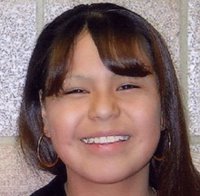November 10, 2005
 I stood there on the spot where she was found a few hours before.
I stood there on the spot where she was found a few hours before.
An 11 year old girl dumped from a car onto the sidewalk…next a funeral home.
There were tokens of love and remembrance – a teddy bear, a Snickers bar, some fresh flowers, a poem, evidence that fear and intimidation could not stop the love of those who dared to reclaim that piece of land.
Sidney Mahkuk did not die of an overdose. She was overdosed. She was murdered. I wondered how it could happen. I wondered, as Sidney’s older sister would ask later at an impromptu memorial service on that same spot,
“Was she lonely? Was she scared? Did she know we cared? Did she know we loved her?”
I never met Sidney. But I felt very close standing alone hours after her death on the spot where someone(s) had dump her body to send a message perhaps to someone else that you’ll end up here – at the funeral home – if you mess with us.
Then it dawned on me why this felt strangely familiar. This violence was not unusual. It was ghastly, but it was not unusual. Ask the prisoners who died at Abu Graib. Ask the parents of the Sidneys in Baghdad and Felujiah and Kabul. Ask the mothers and fathers of the young Americans who have lost their lives for what they were told was the noble cause of disarming Saddam’s weapons of mass destruction and promoting freedom – American mothers and fathers, Iraqi mothers and fathers whose teddy bears and Snicker bars and poems are ignored…because nobody dares to stand there and say that violence and intimidation are not acceptable.
Sidney’s death is unique. Sidney was unique. One of a kind – a Menominee and Potawatome. Sidney was a stranger on her on own native soil. She was American Indian, one of America’s First People, as the Canadians say. But as a stranger on her own soil she is like many of us who, weeping and bewildered, seek to find our way in this strange and foreign land we call America.
The tears falling on the sidewalk beside the funeral home – and only the falling tears – can wash the blues away and lead again joy.
Sometimes I feel all blue
sad sorry blue
all down in minor key
a rhapsody in blue.
Sometimes
when blue begins to play
its melody in me, sometimes
the minor turns to major key –
Blue bursts into purple and,
leaping into joy,
a burst of sun-burst yellow
splashes the blues away
And I feel all clean
all wet all whole up
like a purple-yellow rhapsody,
an Ode to Purple-Yellow Joy.
NOTE: I was Executive Director of the Legal Rights Center when I wrote this piece. The tears still flow. Like too many other cases in Minneapolis’s poorer neighborhoods, Sydney’s case is still “open”.
– Gordon C. Stewart

Thanks for sharing this, Gordon. I shared in on Facebook. It needs to be heard.
LikeLike
Karin, Sydney’s case is one more “case” in the Minneapolis Police Department files. Most deceased are overwhelmingly American Indian and African American with addresses in the Phillips neighborhood (South Minnseapolis) or North Minneapolis. Racial profiling is not just on the street; it’s right there in the police department file drawer. The department knows that a small group of activists will make a scene immediately following a homicide or suspected homicide, and those in charge of investigation assure everyone at these meetings that they will do everything they can to solve the case. Months later the storm has passed and there is nothing to report and no one asking for a report. Tragic and true. This kind of stuff happens all the time. The people in these neighborhoods live with violence from below (gangs/dealers who control their blocks) and from “above” (law enforcement officers playing cops and robbers/cowboys and Indians). Sydney and her family were victims from below and from above.
LikeLike
Chicago suffers much from this sort of inequality, too. And this summer something is making the violence worse in our neighborhoods and on the downtown streets the mayor’s office is so proud of. It makes me wonder if the spreading will do anything to help people understand.
LikeLike
Hi Sparks, I’m sorry, but not surprised. It’s here in Minneapolis, there in Chicago, and every other place where one class, culture, or race has conquered another or have treated those other than themselves as fair game for property. The history of oppression can only be reversed by breaking the mirror. Community orgranizers like Paulo Frere – author of Pedagogy of the Oppressed – have shown the way by teaching the oppressed to free themselves from the conquerors’ image and to organize for radical societal change that refuses to participate in the old game of up/down, oppressor/oppressed, saved/damned, abuser/abused, winner/loser. Without that break in community consciousness, the old patterns of violence continue on the streets of Chicago, in Baghdad, and in Kabul. Thanks for your comment.
LikeLike